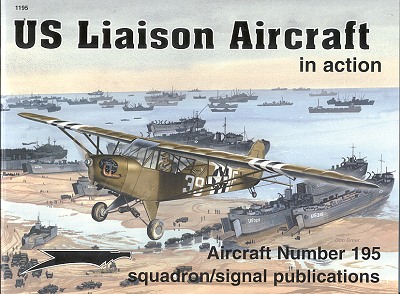 This latest
edition of the 'in action' series covers aircraft that most of us don't
think about when we think about war birds; the light observation or liaison
aircraft. Though this should more properly be titled 'US Liaison Aircraft
in WWII', the book does mention a few of the types used prior to WWII and,
of course, some of the later ones were used in Korea.
This latest
edition of the 'in action' series covers aircraft that most of us don't
think about when we think about war birds; the light observation or liaison
aircraft. Though this should more properly be titled 'US Liaison Aircraft
in WWII', the book does mention a few of the types used prior to WWII and,
of course, some of the later ones were used in Korea.
Typical of the series, there is a brief background history
of the types before getting into the meat of the book, which is the
description of five types that were used during WWII.
The first is the Stinson L-1 Vigilant. This aircraft is
more representative of the pre-war observation aircraft in that it is
relatively large and so not quite as easily maintained in the forward
positions that these planes often found themselves. However, the type
operated throughout the war and was even operated on floats.
Next is theTaylorcraft L-2, the first of the truly light
aircraft that were used for artillery spotting, battlefield observation,
medical evac and as a general hack. It is followed by the Aeronca L-3,
Piper L-4 and Stinson L-5, all light aircraft powered by air-cooled four or
six cylinder engines. The first three of these were also developed into
light training gliders; the TG-6, 7 and 8.
As with all 'in action' books there are color paintings on
the back cover and a center section that has ten superbly done profiles.
Modelers will be pleased to know that several of these have
been kitted in various scales, though a few are short run or resin kits so
may be difficult to locate.
Overall, a very nicely done volume, and one that I can
highly recommend as a super primer on the subject.
You can find this book and many others at

If you would like your product reviewed fairly and quickly by a
site that has 300,000 visitors a month, please contact
me or see other details in the Note to
Contributors.
 This latest
edition of the 'in action' series covers aircraft that most of us don't
think about when we think about war birds; the light observation or liaison
aircraft. Though this should more properly be titled 'US Liaison Aircraft
in WWII', the book does mention a few of the types used prior to WWII and,
of course, some of the later ones were used in Korea.
This latest
edition of the 'in action' series covers aircraft that most of us don't
think about when we think about war birds; the light observation or liaison
aircraft. Though this should more properly be titled 'US Liaison Aircraft
in WWII', the book does mention a few of the types used prior to WWII and,
of course, some of the later ones were used in Korea.